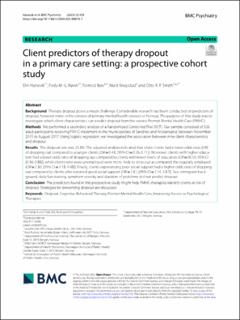| dc.description.abstract | Background
Therapy dropout poses a major challenge. Considerable research has been conducted on predictors of dropout, however none in the context of primary mental health services in Norway. The purpose of this study was to investigate which client characteristics can predict dropout from the service Prompt Mental Health Care (PMHC).
Methods
We performed a secondary analysis of a Randomized Controlled Trial (RCT). Our sample consisted of 526 adult participants receiving PMHC-treatment in the municipalities of Sandnes and Kristiansand, between November 2015 to August 2017. Using logistic regression, we investigated the association between nine client characteristics and dropout.
Results
The dropout rate was 25.3%. The adjusted analysis indicated that older clients had a lower odds ratio (OR) of dropping out compared to younger clients (OR = 0.43, [95% CI = 0.26, 0.71]). Moreover, clients with higher education had a lower odds ratio of dropping out compared to clients with lower levels of education (OR = 00.55, 95% CI [0.34, 0.88]), while clients who were unemployed were more likely to drop-out as compared the regularly employed (OR = 2.30, [95% CI = 1.18, 4.48]). Finally, clients experiencing poor social support had a higher odds ratio of dropping out compared to clients who reported good social support (OR = 1.81, [95% CI = 1.14, 2.87]). Sex, immigrant background, daily functioning, symptom severity and duration of problems did not predict dropout.
Conclusion
The predictors found in this prospective study might help PMHC-therapists identify clients at risk of dropout. Strategies for preventing dropout are discussed. | en_US |

